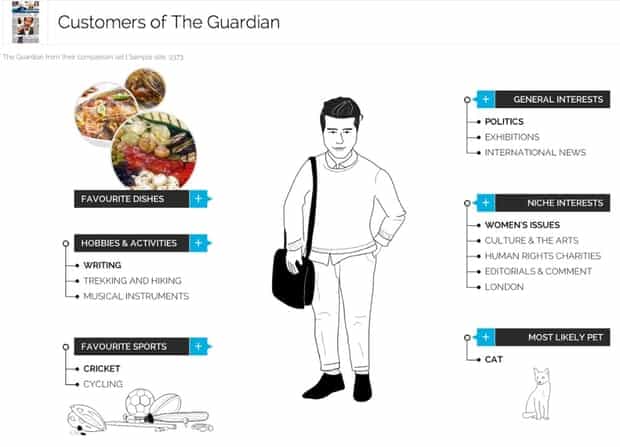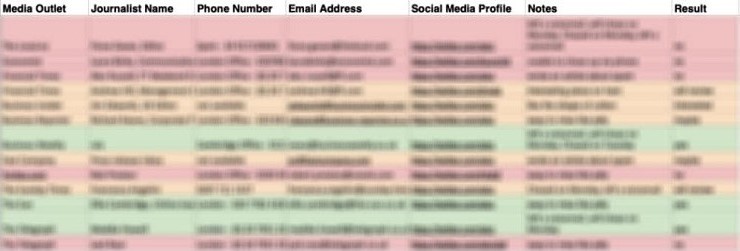If you’re looking to promote your business offline, there are few more effective ways to do it than landing a story in the traditional media. A mention in the New York Times, or a short appearance on CNN gets you in front of millions of potential customers.
Look at any company website and you’ll see how such exposure is frequently used to validate a business. The “as seen in” tagline is even used in investor pitch decks for funding rounds.
But securing an appearance on TV, in a newspaper, or on the radio takes time, and an understanding of how the media operates. In this article I will show you a tried and tested strategy for landing a story in the press that you can follow to promote your business.
I’ll then show you how you can use that exposure to leverage more media opportunities. In fact, if you’re currently working on a pitch, I’m providing feedback to the first 10 people who leave a comment at the bottom of this post. You’ll have to read the post before leaving the comment though 😉
Let’s get started.
Table of Contents
How to Craft an Interesting Story
How to Create Your Press List
How the Media Works
The Pitch: Doing Press Outreach
BONUS (I’ll Review Your Pitch!)
How to Craft an Interesting Story
The starting point for any great campaign to grow your business through the media is your story. There are two stakeholders you need to satisfy when crafting a story:
- The target audience, essentially your ideal customers, that your campaign will appeal to
- The journalist, editor, or producer you are pitching to
These two stakeholders have different priorities. The main problem here is that journalists likely aren’t going to be interested in the story you want to tell your customers, because they have no interest in promoting your business, unless you pay them of course. They are interested in a good, newsworthy story though.
Just What is Newsworthy?
A good story in the news shares a lot of the same characteristics as a good story in a book. Interesting news stories provoke an emotional reaction with the audience; sadness, excitement, surprise, anger, etc.
Here is a list of important factors journalists look for in a good story:
- The Shock Factor: Shocking news often has a widespread impact. It could be the death of a celebrity, an extreme weather event, unexpected sports victory, a political event, etc. In terms of promoting your business, it could be revealing an unexpected insight into your industry (something of interest to industry-specific publications).
- Uniqueness: Something can be newsworthy simply because it’s unusual. For example, “Man cycles to work” is not a news story. “Man cycles to work every day for 10 years on a unicycle” might be.
- Proximity: Audiences relate to news that is close to them geographically, or that they can relate to culturally, socially, or through shared interests and values.
- Continuity: Events that are likely to develop and require future updates make for a good news story. This includes things like a conflict, political events, etc.
- Simplicity: Complex stories require more context. This means more printed words, or time on a TV segment. This makes simple stories an easier sell in the press.
- Size: The more people are impacted by the event, the larger the potential audience for the story. The more money or resources involved, the larger the audience. For example, “Man wins $222 million on the lottery” is more interesting than “Man wins $1 million on the lottery.”
- Personality: These are stories centered on individuals. They could include things like the personal life of a member of the royal family. It’s the kind of thing that you see a lot of in the gossip columns of celebrity magazines. Richard Branson has been very good at generating news coverage around his personality, using stunts like trying to circle the world in a hot air balloon, and attempting a trans-Atlantic sailing record, which generate huge exposure for Virgin.
- The Elite: A story about an important person, state, or business has more value than a story that covers a less important one.
- Timeliness: Breaking news about something that has only just occurred will gain interest across the media. “Old news” that’s already been covered or overshadowed by new events generates less interest.
- Exclusivity: Journalists love to be the first or only ones to land a story. As a result, if the news outlet is the first to be presented with a story, they may be more likely to cover it.
Keep in mind that the story will almost never be a straight explanation of your business and what it does. There has to be that larger sense of newsworthiness.
For example, you could run a survey that provides interesting insights into your industry, or insights into another industry. YouGov, a market research firm, ran an interesting data-driven marketing campaign targeting the media, which got them a headline in The Guardian.
This YouGov pitch combines a number of different factors journalists look for in a story. The most important hook is proximity. The article is also relevant to both the journalist and readers. I can imagine a Guardian reader chatting over breakfast about how they hate cats, and don’t play any musical instruments, for instance.
Alternatively, you could develop a creative advertising campaign that becomes the story. The Harmon Brothers are experts at this. The video below is from a campaign they ran for a company called Purple.
The video was watched 150 million times on Youtube. The success of the advertising campaign, combined with the interesting product they developed, got the company featured in Forbes, and Furniture Today.
The interesting thing about this story is there are multiple angles to it. On the surface, there is a story about size—the number of views. I could see this video being listed on Mashable in a list of the most watched YouTube videos ever for instance. Dig a little deeper, though, and you realize that there is also a serious business angle in here as well, which is what the article on Forbes focused on.
Creating a unique advertising campaign is a solid hook for landing a story in a newspaper. HomeAdvisor, for example, ran an innovative advertising campaign based on re-imagining the front room of the Simpsons’ home.
This campaign received coverage in Today, among other publications.
One thing that you’ll notice if you research any of these examples is that each of these stories was covered multiple times in the press. There’s a good reason for this.
A Little Secret About the Media
There’s an inside joke among journalists that people working at newspapers spend their days watching the news on TV, while everyone on TV reads the newspapers.
Of course, there’s an element of truth to the joke.
An exclusive story published at a national TV station or newspaper with a large audience is often picked up by other media outlets and republished. Each time the story is republished, more people see it (and the cycle continues).
The PR industry understands how this news cycle works. This is why they normally target a limited number of these large organizations. This brings us nicely onto the next section.
How to Create Your Press List
Once you’ve got your story, you need to figure out what media outlets you want to focus on. I recommend you start this process by creating a spreadsheet in Google Docs or another program.
The sheet I use for a presslist always has the same format:
- Media Outlet
- Journalist Name
- Phone Number
- Email Address
- Social Media Profile
- Notes
- Result
Begin by listing all of the media outlets that you want to target. You will probably have the outline of a press list in your mind before you start the process. It’s often a bit of a wishlist: ”Wouldn’t it be great if we were featured in/appeared on…”
This wishlist normally overlaps with the publications that your target customer consumes. I recommend targeting 30-50 media outlets across TV, radio, podcasts, and print.
For print media, once you have identified the media publication, try to identify the journalist or editor you want to pitch your story to. This part of the research is essentially a case of following links. You can either:
- Research whether the content around the topic you want to pitch has been published in the past by your target publication. You can normally do this online using Google.
- Go to the relevant section of the paper, for instance Lifestyle, and review the articles to find the most appropriate journalist.
As you do this research, and identify relevant reporters, make sure to add notes to your spreadsheet. I normally include basic things like what the journalist wrote about recently. This information will be useful later when you pitch your story to the journalist.
Collect Contact Details
Most print and web-based publications make it easy for you to find the contact details of the relevant reporter. Many publications have a contact page where you can find the name and email address of reporters, and editors.
For publications that don’t provide the contact, a quick Google of the name of a reporter + email address generally gets you the result you’re looking for. Alternatively, most media outlets use a simple email formula for staff. This is normally some variation of:
- firstname.lastname@publication
- firstnamelastname@publication
There are also plenty of email software platforms that can be used to find an email address. These include tools like Hunter, Any Mail Finder, and Lusha.
In addition to finding the email address for a specific reporter or editor, you also want the office phone number. There’s normally a phone number on the contact page.
Finding the phone number for a TV program is more difficult, because they usually don’t provide this information online.
I normally start by finding out where the program you want to contact is filmed. For example, in the UK a lot of content for the BBC is created at a mixed-use property development in Greater Manchester called Media City.
If I want to contact a program created by the BBC in Greater Manchester there is a good chance they are based here. Fortunately it’s quite easy to find the phone number for the Media City switchboard on Google. You can use this same approach to find the phone number for a lot of TV programs.
The same approach works well for radio.
Once you’ve filled in the press list you’re almost ready to start with outreach. Before I get into that, I’ll share a bit about how the media works, and some of the key terms you should know.
How the Media Works
Every news organization has content targets they need to hit. For print media there is normally a set number of articles that need to be produced to fill the paper. This is referred to as the “news hole” in the industry.
Most newspapers that have daily print schedules hold planning meetings in the morning where journalists will pitch stories to their editors, and editors will assign stories to journalists. Content is then compiled and produced throughout the day to fill the hole.
At the end of the day the paper is sent to the printers.
A magazine has a similar print cycle, it’s just that the process takes longer. If you’re pitching to a magazine with a time-sensitive story, it’s important to find out the print deadline. For a monthly magazine, the print deadline might be halfway through the previous month.
Radio and television have the same general news cycles as print media. Scheduling for a program is organized through a planning meeting. In the UK, the name of the body that runs this meeting is the Planning Department. This might not be the case where you’re located. However, all media outlets have planning meetings where they decide what content to include in a program.
When you pitch your story, you will need to talk to someone who is involved in the planning meeting. Now let’s cover some journo terms.
Terminology You Need to Know
Journalists, like any professionals, have their own lingo. Two important terms you might want to use when you pitch your story are embargo and exclusive.
A story under embargo can not be published until a certain date. For example, you might have a story that you are promoting to multiple media outlets, and you’ll give them the details to begin their reporting, but you ask that the story not be published until July 3. This is the embargo date.
An exclusive is a story that you offer to one media publication. You can use the offer of an exclusive to increase the chance of a media publication covering the story (remember that exclusivity appeal I mentioned in the newsworthy section?).
These two concepts can be combined. An exclusive story can be under embargo until a certain date. Generally, reporters will understand and abide by these terms.
Key Differences Between TV, Radio, and Print
The final thing I want to cover before looking at how to pitch to the press are the differences between the three mediums. Below is a quick summary of some things to keep in mind:
- Radio: Radio is based on audio. It’s a good medium for interviews, and human interest stories. It’s a difficult format to use for anything where you need to spend a lot of time describing what’s going on.
- TV: TV is a visual medium. It can be difficult to get the right visuals to go with a story, so events are popular. They can offer an opportunity to cover a story that a journalist has wanted to do, but never had the right visuals. Studio interviews, of course, work well and often don’t need visuals.
- Print: Print is probably the best all round medium for a story. It is not as constrained as radio over descriptions as photos are often used to provide visual clues for content.
The differences in these three mediums are obvious, but they are important. For example, if you wanted to cover a story about VR across the different mediums, there would be differences in how you pitch the story, and how a journalist would likely cover the story.
The Pitch: Doing Press Outreach
Most people start their press outreach with a press release. I recommend you start by phoning a journalist. Only after you’ve spoken to them should you send your press release.
The reason is that journalists get pitched stories constantly. The larger the outlet they work for, the more stories they get pitched. Most of these are boring, or worse, irrelevant.
In addition, the majority of pitches are made by email. By use a less common communication channel, you stand out. This increases the chance of landing your story.
How to Refine a Winning Phone Pitch
The first thing I do before phoning a journalist is write the numbers 1, 2, and 3, on a blank piece of paper. Alongside these numbers I write the three most interesting things about the story I am pitching.
For example, I arranged for a journalist from the Sunday Times to come to the city I was working in to visit clients who were involved in the tech sector. The three angles I settled on, which convinced the journalist to visit, were:
- Size: Bristol is the largest tech cluster outside of London. To illustrate this point I noted relevant figures that I knew would interest him. This included the number of people employed in the tech scene, and the value of the tech sector.
- Proximity: While the journalist was aware of this fact, I decided to highlight that most members of the general public in the area nearby were not.
- Exclusivity: A number of the clients I worked with were involved in the technology scene. As a result, I could offer the journalist exclusive access to interview a number of managing directors from technology firms based in the city.
When combined, these three points stack on top of each other to make a convincing case for the journalist to cover the story. Fundamentally, these points answered the question, “Why should I (the journalist) care?”
Under each bullet point, I write a short paragraph that goes into a bit more depth about each point. I’ll step away for an hour or so, then review the points again. If I’m happy with them, I pick up the phone and call the first number on the press list. I normally start each phone call like this:
Hi. My name’s Nico and I’m from ORGANIZATION. Do you have three minutes spare? I want to quickly pitch a story I think you’d be interested in.
With this introduction, I clearly deal with who I am, and why I’m contacting the person. It also gives the individual the chance to say, “No I’m busy.”
Nine out of 10 times a person will agree, or say that they’re busy but can spare just a minute. Either answer provides me with an opportunity to pitch a story.
If they turn you down, I recommend you ask what their editorial focus is. This could give you an opening for a future pitch.
Make sure as you end the phone conversation, especially if it’s on a positive note, to clearly outline the next steps you will take. This could be something like:
Thanks. I’ll send you a press release by email after the phone call. If I haven’t heard back from you within the next 48 hours I will phone your office again. When would be the most convenient time to phone?
This is important, because I can almost guarantee that the first thing a journalist will do when they hang up that phone is forget they talked to you.
Another tip is, if you have an opportunity, try to make the person laugh. And make sure to personally engage with them. All of this will help you land the story.
That said, be prepared for some people to be rude.
If that happens, don’t take it personally. There’s a number of reasons they could be annoyed, including the fact that you’re a stranger calling them on the phone.
The Contextual Press Release
Follow up your phone call with what I call a contextual press release. This is a couple of paragraphs with maybe a few bullet points outlining the story (it’s a lot like a guest post pitch—you can find some good templates here). This email contains all of the important information a journalist would need to write a story.
Send this through to the journalist with the press release attached.
The reason I don’t rely on the press release itself is that most journalists won’t download it. In fact, many journalists who specifically ask for a press release in my first phone call haven’t gotten around to downloading it the second time I get in touch.
Final Steps
Hopefully a few of the journalists you contact using this outreach process will be interested in the story that you sent them. Should this be the case then the next steps in getting the story published are pretty simple.
With print, a journalist might ask you for relevant images, background information or possible a quote. For radio or TV there’s a reasonable chance that you, or a spokesperson for the company will be asked to attend an in person interview.
If you do get covered in the press don’t relax and take it easy. Use any exposure you received as a new opportunity to reach out to more journalists, or those people who were sitting on the fence. You can even use blogger outreach tools to automate the outreach process to smaller media bodies, and bloggers and influencers in your niche.
Conclusion + BONUS (I’ll Review Your Pitch!)
I hope this article has given you a clear overview of how to engage with the media to promote your business offline. If you have an interesting story to share and you apply the tactics in this post, you’ll generate exposure for your business.
With the right strategy in place, you can leverage this exposure for new marketing campaigns, or to place your company as an authority figure in your niche. Moreover, those relationships you develop with journalists will make it easier to land a story the next time you run a marketing campaign.
Even if you don’t use the tactics shared in this post, you will at least have an understanding of the strategies that a PR company is using to promote your business offline. Now it’s over to you!
Are you looking for feedback on a pitch you’re making? Do you have any questions about things I covered in the article? Leave a comment below. I’ll be sure to respond to every comment, and if you’re one of the first 10 people to comment I’ll be happy to provide feedback on your pitch.





















